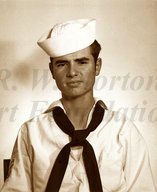
|

|
|
|
|
Although he does not go by junior, William was born at Tri-State Hospital in Shreveport to William J. and Maddie Hazel Adams Harrison. He had one sister. His father, a driller, moved the family often as he followed work in the oil fields, where housing often was substandard. "We were always lucky to live in a house," William recalls. "Lots of them were just those sawmill board houses. A lot of people would take old signboards or any kind of thing they could find and make them some kind of hut to live in. Lot of people lived in tents, anything to get out of the weather." William's parents separated when he was thirteen, and he lost track of his father, who died in 1979. "The only way I knew he died I saw a piece in the paper," he remarks. (Earlier, his mother married Carl D. Spradley of Deadwood, Texas.) As a young boy, William attended several schools in East Texas, where his father worked in oil fields, before moving in with his grandparents, Claude and Emma Marie Davidson Adams in Bethany, Texas. William worked on the farm, especially after his grandfather's death in 1940. When America entered World War II, William wanted to join the U.S. Navy. Although his mother refused to sign a release for him to enter the Navy, she approved his entry into the Merchant Marines in the summer of 1944, before he finished high school in Greenwood, Louisiana. "I always wanted to be a sailor," he says. William completed boot camp in St. Petersburg, Florida, on March 15, 1945. He was sent to the Coco Solo Naval Base on the Panama Canal where he received his assignment and boarded a liberty ship, SS Salmon P. Chase. The ship, loaded with construction equipment stopped briefly in Hawaii, then delivered the equipment to Samar in the Philippines. He recalls his shifts aboard the vessel as four hours on, four hours off. William's battle station was passing projectiles from the magazine to a three-inch gun in the bow. Eventually the Salmon P. Chase sailed for Portland, Oregon, where William obtained a 20-day leave. After a visit at home, he was reporting for duty in Houston when the war ended. William went to work for his stepfather in a store in Spring Ridge, Louisiana, then completed high school in Greenwood, Louisiana. He later worked as a roughneck and then for Arkansas Louisiana Gas Company until the U.S. Army drafted him in 1950, soon after the outbreak of the Korean War. He was sent to Fort Jackson near Columbia, South Carolina, then to Fort Bragg near Fayetteville, North Carolina, and assigned to the 426th Field Artillery, a unit in the North Carolina National Guard, as a cannoneer of an eight-inch howitzer. After a year at Fort Bragg he was sent to Germany, where he was stationed for a year in Bavaria. In the summer of 1952 he was discharged at Fort Jackson and returned to work for Arkansas Louisiana Gas Company where he eventually was as a welder in building gasoline plants. In March of 1955 he married Bettie Joe Webb. (They would have one daughter.) William then entered the U.S. Air Force in 1956. "I wanted to work on airplanes," he recalls. Trained as a hydraulic technician at a technical school in Amarillo, Texas, he was sent to Tinker Air Force Base in Midwest City, Oklahoma. In 1960 he was sent to an air base near Rushden, England, where he worked on B-66 reconnaissance planes. Later, Bettie Joe and their daughter joined him. After two years in England, he served for a year at Toul-Rosieres Air Base near Nice, France. Back in America he was stationed at Dyess Air Force Base in Abilene, Texas, where he worked on B-52s and KC-135s until the summer of 1966 when he was sent to Clark Air Force Base on Luzon in the Philippines. There he served 18 months, also pulling TDY (temporary duty) in Vietnam, Thailand, and Taiwan. His family was not with him. "All the time I was in the service I spent seven years away from my family," he recounts. In 1967 he returned home and was sent to Webb Air Force Base near Big Spring, Texas. After a year there he was ordered to South Vietnam in 1970, checking hydraulic parts of F-100s down the intake of an airplane. "I came out and found they were shooting off flares to celebrate the New Year. "Scared me to death! I thought we were having an attack!" he remembers. William returned and served at Webb Air Force Base and Castle Air Force Base in Atwater, California. He spent a year in Korea, then retired on April 1, 1975 at Barksdale Air Force Base. He went to work for Clark Forklift in Shreveport, retiring on June 7, 1993. |


